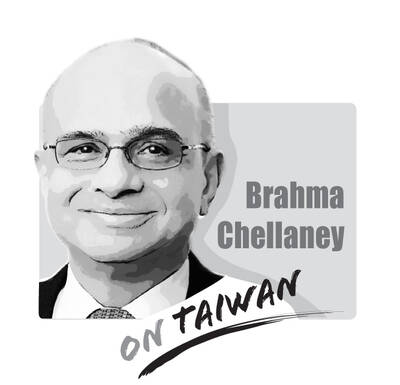The Chinese Communist Party (CCP) has successfully leveraged the cross-strait service trade agreement to waste Taiwan’s national resources. It has also inflicted a great deal of physical and psychological harm on Taiwanese. Throughout the entire process of negotiating and signing the agreement, the CCP has not lost a single thing, while Taiwan has been severely hurt in many ways.
This is the inevitable outcome of President Ma Ying-jeou’s (馬英九) proactive stance over interactions with China.
In the eras of former president Chiang Kai-shek’s (蔣介石) resistance to Russia and his anti-communist drive and his son Chiang Ching-kuo’s (蔣經國) — who had a strategy of “no negotiation, no contact and no compromise” with China — Taiwanese lived through a White Terror era under the one-party dictatorship of the Chinese Nationalist Party (KMT).
However, none of that was as frightening as the “Red Terror” that now exists under Ma’s dictatorial leadership. People may think that Taiwan democratized a while ago, but, during his second term in office, Ma has sped up and increased the scope of his moves to promote unification with China.
As a result, Taiwanese feel that their way of life is about to change, that their abilities to make a living and even just get by are being destroyed and that the nation is about to become a part of communist China. This is the reason Taiwanese are so terrified now.
China does not even have to shoot a single bullet to take over Taiwan. However, it does need the cooperation of the pro- unification forces in Taiwan.
There are two pro-unification factions. The leftist faction views things through the lens of politics, while the rightist faction looks from a historical and cultural perspective. However, these factions have recently converged.
This convergence is no more apparent than in the actions of the members of the high-school curriculum adjustment task force. The main factor that has brought the left and right together in such an unimaginable way is “Chinese nationalism.”
The pro-unification faction believe that ethnicity is something higher than democracy and that bloodline is more important than freedom.
This is a common view that the CCP, the KMT and the pro-unification faction share. It is also something that they use to respond to and suppress civic movements both in Taiwan and in China.
Ma is using the service trade agreement to make Taiwan’s economy merge with and eventually be absorbed by China’s, just as he is using the high-school curriculum adjustment task force to force Taiwanese into thinking that they are “Chinese” in an attempt to gain control over both the public’s bodies and minds.
It is correct for the “Sunflower student movement” to base its actions around a civic movement because this makes a direct contribution to the protection of Taiwan’s freedom and democracy. However, the students cannot afford to overlook the fact that the specter of Chinese nationalism is the true enemy as Taiwanese and Chinese seek their own democracy and freedom.
Chang Bing-yang is a professor at the National Taipei University of Education.
Translated by Drew Cameron

Taiwan stands at the epicenter of a seismic shift that will determine the Indo-Pacific’s future security architecture. Whether deterrence prevails or collapses will reverberate far beyond the Taiwan Strait, fundamentally reshaping global power dynamics. The stakes could not be higher. Today, Taipei confronts an unprecedented convergence of threats from an increasingly muscular China that has intensified its multidimensional pressure campaign. Beijing’s strategy is comprehensive: military intimidation, diplomatic isolation, economic coercion, and sophisticated influence operations designed to fracture Taiwan’s democratic society from within. This challenge is magnified by Taiwan’s internal political divisions, which extend to fundamental questions about the island’s identity and future
The narrative surrounding Indian Prime Minister Narendra Modi’s attendance at last week’s Shanghai Cooperation Organization (SCO) summit — where he held hands with Russian President Vladimir Putin and chatted amiably with Chinese President Xi Jinping (習近平) — was widely framed as a signal of Modi distancing himself from the US and edging closer to regional autocrats. It was depicted as Modi reacting to the levying of high US tariffs, burying the hatchet over border disputes with China, and heralding less engagement with the Quadrilateral Security dialogue (Quad) composed of the US, India, Japan and Australia. With Modi in China for the
The Chinese Nationalist Party (KMT) has postponed its chairperson candidate registration for two weeks, and so far, nine people have announced their intention to run for chairperson, the most on record, with more expected to announce their campaign in the final days. On the evening of Aug. 23, shortly after seven KMT lawmakers survived recall votes, KMT Chairman Eric Chu (朱立倫) announced he would step down and urged Taichung Mayor Lu Shiow-yen (盧秀燕) to step in and lead the party back to power. Lu immediately ruled herself out the following day, leaving the subject in question. In the days that followed, several
The Jamestown Foundation last week published an article exposing Beijing’s oil rigs and other potential dual-use platforms in waters near Pratas Island (Dongsha Island, 東沙島). China’s activities there resembled what they did in the East China Sea, inside the exclusive economic zones of Japan and South Korea, as well as with other South China Sea claimants. However, the most surprising element of the report was that the authors’ government contacts and Jamestown’s own evinced little awareness of China’s activities. That Beijing’s testing of Taiwanese (and its allies) situational awareness seemingly went unnoticed strongly suggests the need for more intelligence. Taiwan’s naval